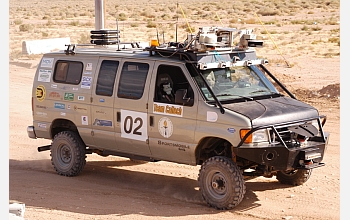Media Advisory 07-010
Urban Challenge: How to Design a Self-Driving Car
Race set for November 2007; researcher will discuss as part of lecture series on April 9 at NSF
April 3, 2007
This material is available primarily for archival purposes. Telephone numbers or other contact information may be out of date; please see current contact information at media contacts.
Free of drivers or remote control, a handful of cars, vans and SUVs guided only by on-board computers will drive a closed, urban course, bypassing obstacles and each other in a race on November 3, 2007.
The race demonstrates how these unmanned vehicles help the United States military safely operate supply missions. In order to help the public understand how these vehicles work, the National Science Foundation (NSF) will present a lecture on April 9, 2007, by Richard Murray, an NSF-supported researcher who leads the California Institute of Technology (Caltech) challenge team, who will discuss how these cars are designed.
|
Who: |
Richard Murray, California Institute of Technology |
|
What: |
NSF Directorate for Engineering Distinguished Lecture: How to Design a Self-Driving Car |
|
When: |
Monday April 9, 2007, 2 p.m. - 3p.m. |
|
Where: |
National Science Foundation |
Seating is limited and available on a first come, first served basis. Media should contact Josh Chamot in the Office of Legislative and Public Affairs (jchamot@nsf.gov; (703) 292-7730). For additional information, contact Radhakisan Baheti, NSF program director in the Power, Controls and Adaptive Networks (PCAN) program (rbaheti@nsf.gov; (703)-292-8339).
Called the Urban Challenge and sponsored by the Defense Advanced Research Projects Agency (DARPA), the race is the latest in the Grand Challenge series of autonomous vehicle races. The urban location of the race will be revealed on August 10, 2007. The prize is a $2 million.
-NSF-
ABSTRACT
The Defense Advanced Research Projects Agency (DARPA) Grand Challenge is a competition in which teams from around the country conceive, design and implement autonomous vehicles capable of driving themselves. In 2004 and 2005, the grand challenge involved driving up to 150 miles in desert environments, at speeds of up to 40 miles per hour. In November 2007, DARPA will sponsor the third grand challenge race, the Urban Challenge, which will involve driving up to 60 miles on city streets, including interacting with other (autonomous) vehicles. The California Institute of Technology (Caltech) has participated in the last two races, and this talk will summarize some of the challenges and successes that Team Caltech faced in designing their latest vehicle, "Alice." Key features of "Alice" include a highly sensory-driven approach to fuse sensor data into speed maps used by real-time trajectory optimization algorithms, health and contingency management algorithms to manage failures at the component and system level, and a multi-threaded, networked control architecture that enables plug- and-play operations and testing.
BIOGRAPHY
Richard M. Murray received a bachelor's degree in electrical engineering from California Institute of Technology in 1985 and a master's and doctorate degrees in electrical engineering and computer sciences from the University of California, Berkeley, in 1988 and 1991, respectively. He is currently the Thomas E. and Doris Everhart Professor of Control and Dynamical Systems and the director for information science and technology at the California Institute of Technology, Pasadena. Murray's research is in the application of feedback and control to mechanical, information, and biological systems. Current projects include integration of control, communications, and computer science in multi-agent systems, information dynamics in networked feedback systems, analysis of insect flight control systems, and synthetic biology using genetically-encoded finite state machines. Murray is currently developing a new course at Caltech that is aimed at teaching the principles and tools of control to a broader audience of scientists and engineers, with particular emphasis on applications in biology and computer science.
Media Contacts
Joshua A. Chamot, NSF, (703) 292-7730, email: jchamot@nsf.gov
Marionne Epalle, California Institute of Technology, (626) 395-8093, email: marionne@caltech.edu
Program Contacts
Radhakishan Baheti, NSF, (703) 292-8339, email: rbaheti@nsf.gov
The U.S. National Science Foundation propels the nation forward by advancing fundamental research in all fields of science and engineering. NSF supports research and people by providing facilities, instruments and funding to support their ingenuity and sustain the U.S. as a global leader in research and innovation. With a fiscal year 2023 budget of $9.5 billion, NSF funds reach all 50 states through grants to nearly 2,000 colleges, universities and institutions. Each year, NSF receives more than 40,000 competitive proposals and makes about 11,000 new awards. Those awards include support for cooperative research with industry, Arctic and Antarctic research and operations, and U.S. participation in international scientific efforts.
Connect with us online
NSF website: nsf.gov
NSF News: nsf.gov/news
For News Media: nsf.gov/news/newsroom
Statistics: nsf.gov/statistics/
Awards database: nsf.gov/awardsearch/
Follow us on social
Twitter: twitter.com/NSF
Facebook: facebook.com/US.NSF
Instagram: instagram.com/nsfgov



